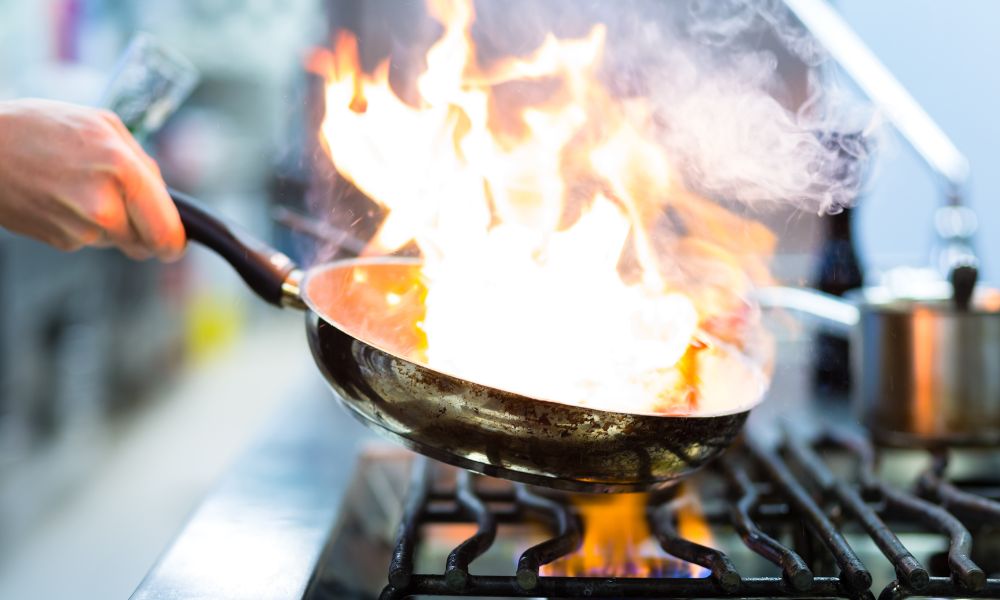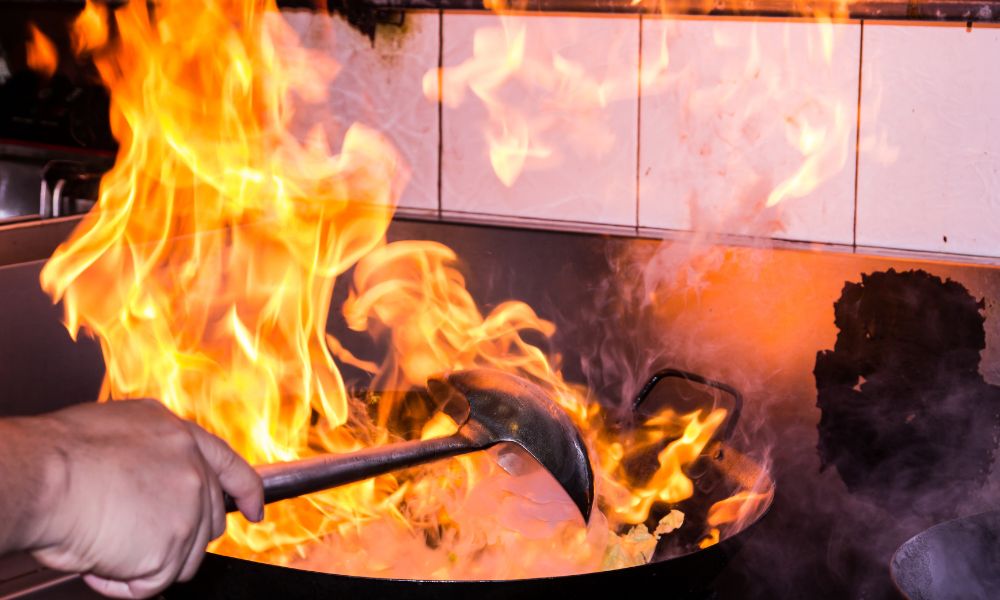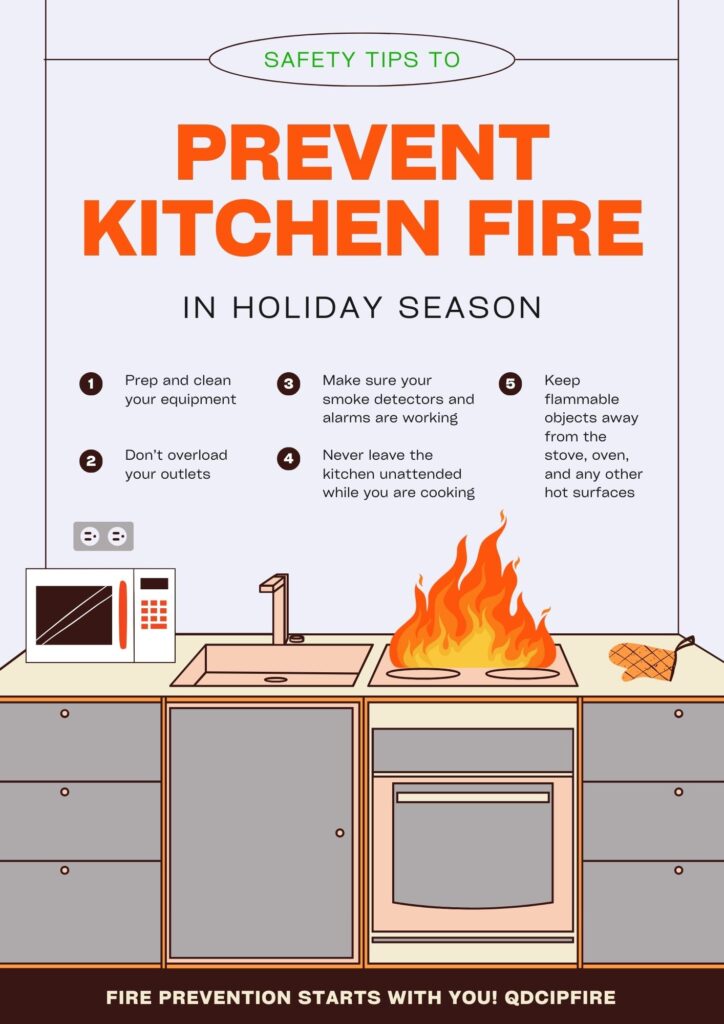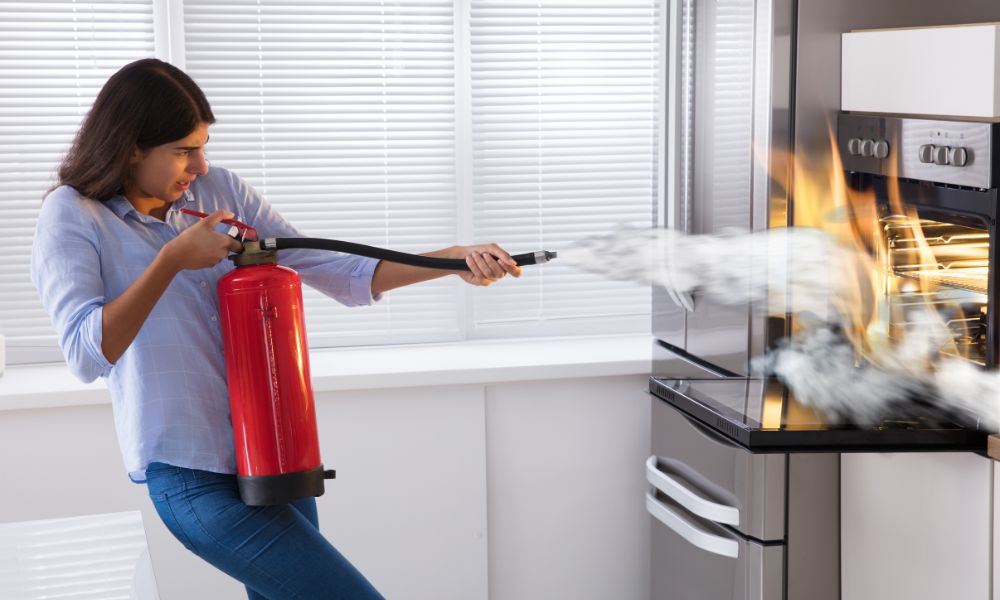Every year, hundreds of thousands of kitchen fires occur in homes across the United States. Many of these fires could have been prevented with proper fire safety measures.
The kitchen is the most common location for home fires to start, and it’s important to take steps to reduce the risk of a fire starting in this area.
One of the most important fire safety measures in the kitchen is to keep flammable items away from the stove. This includes paper towels, dish towels, and oven mitts.
These items can easily catch fire if they come into contact with a hot burner or flame. It’s also important to avoid wearing loose clothing while cooking, as this can easily catch fire as well. By keeping the area around the stove clear and avoiding loose clothing, the risk of a kitchen fire can be greatly reduced.
Fundamentals of Fire Safety in the Kitchen
The kitchen is one of the most common places in a home where fires can occur. Therefore, it is essential to follow some fundamental fire safety rules in the kitchen to prevent the risk of fire.
Keep Your Kitchen Clean and Tidy
A cluttered kitchen can increase the risk of fire. It is essential to keep the kitchen clean and tidy to avoid any potential fire hazards. Grease, oil, and food residue can accumulate on kitchen surfaces, which can ignite and cause a fire. Therefore, it is crucial to clean the kitchen regularly and dispose of any flammable materials properly.
Use Cooking Appliances Safely
Cooking appliances such as stovetops, ovens, and microwaves can be dangerous if not used correctly. Always read the manufacturer’s instructions before using any cooking appliance and follow them carefully. Never leave cooking appliances unattended while in use, and always turn them off when you’re finished cooking.
Keep Flammable Materials Away from Heat Sources
Flammable materials such as paper, plastic, and cloth should be kept away from heat sources in the kitchen. Heat sources include stovetops, ovens, toasters, and any other cooking appliance that generates heat. It is essential to keep these materials at a safe distance to prevent them from igniting and causing a fire.
Have a Fire Extinguisher and Smoke Detector
Having a fire extinguisher and smoke detector in the kitchen can be a lifesaver in case of a fire. A fire extinguisher can help put out a small fire before it becomes more significant, while a smoke detector can alert you to the presence of smoke or fire. Make sure to test your smoke detector regularly and replace the batteries when needed. Also, ensure that your fire extinguisher is up to date and in good working condition.
By following these fundamental fire safety rules in the kitchen, you can reduce the risk of fire and keep your home and loved ones safe.
Identifying Fire Hazards in the Kitchen
When it comes to fire safety in the kitchen, identifying potential fire hazards is the first step in preventing them. Here are some common fire hazards to watch out for:
Electrical Appliances
Electrical appliances are a common cause of kitchen fires. Faulty wiring, damaged cords, and overheating can all lead to electrical fires. To prevent this, it’s important to regularly inspect your appliances for any signs of damage or wear and tear. Make sure to unplug appliances when not in use and never leave them running unattended.
Flammable Materials
Flammable materials such as paper towels, dish towels, and curtains can easily catch fire if they come into contact with a heat source. Keep flammable materials away from stovetops, ovens, and other heat sources. It’s also important to keep the kitchen clean and free of clutter to prevent fires from spreading.
Cooking Oils and Grease
Cooking oils and grease can easily ignite if they become too hot. Always keep a close eye on your cooking oils and never leave them unattended on the stove. If a fire does occur, never attempt to extinguish it with water, as this can cause the fire to spread. Instead, use a fire extinguisher or baking soda to smother the flames.
By being aware of these common fire hazards and taking steps to prevent them, you can help keep your kitchen safe and prevent fires from occurring.
Preventive Measures and Best Practices

Safe Cooking Habits
When it comes to fire safety in the kitchen, prevention is key. One of the most important preventive measures is practicing safe cooking habits.
This includes always keeping an eye on the stove while cooking, never leaving cooking food unattended. It is also important to keep flammable items such as oven mitts, towels, and paper products away from the stove.
Another important safe cooking habit is to avoid wearing loose clothing while cooking. Loose clothing can easily catch fire if it comes in contact with a hot stove or an open flame.
It is also important to avoid cooking when feeling drowsy or under the influence of alcohol or drugs.
Maintenance of Kitchen Equipment
Proper maintenance of kitchen equipment is also crucial for fire safety in the kitchen. Regularly cleaning the stove and oven can help prevent grease buildup, which can easily ignite and cause a fire.
It is also important to regularly inspect and maintain kitchen appliances, such as the stove, oven, and microwave, to ensure they are in good working condition.
If any defects or malfunctions are found, they should be repaired immediately. Additionally, it is important to ensure that all electrical equipment is properly grounded and that cords are not frayed or damaged.
Proper Storage of Flammable Items
Proper storage of flammable items is another important preventive measure for fire safety in the kitchen. Flammable items such as cooking oils, cleaning supplies, and aerosol cans should be stored in a cool, dry place away from heat sources and open flames.
It is also important to properly dispose of flammable items, such as used cooking oil, in a metal container with a tight-fitting lid. This will help prevent the risk of spontaneous combustion.
By following these preventive measures and best practices, individuals can help ensure fire safety in the kitchen and reduce the risk of a potentially dangerous situation.
Emergency Response and Equipment
Using a Fire Extinguisher
In case of a fire, it is important to have a fire extinguisher readily available and know how to use it. The acronym PASS (Pull, Aim, Squeeze, Sweep) can help individuals remember the steps to use a fire extinguisher. Pull the pin, aim the nozzle at the base of the fire, squeeze the handle, and sweep the extinguisher from side to side.
It is important to remember that fire extinguishers have limitations and should only be used on small fires. If the fire is too large or spreading quickly, evacuate the area and call the fire department.
Fire Blankets and Their Use
Fire blankets can be used to smother small fires or wrap around a person on fire to extinguish the flames. To use a fire blanket, first, ensure that the blanket is within easy reach.
Then, carefully pull the blanket out of its container and hold it in front of you. Approach the fire slowly and gently place the blanket over the flames. Leave the blanket in place for several minutes to ensure that the fire is completely extinguished. If using a fire blanket to wrap around a person, make sure to cover the person’s face and head.
Emergency Evacuation Procedures
It is important to have an emergency evacuation plan in case of a fire. This plan should include a designated meeting place outside of the home or building, a clear path to exit the area, and a method for alerting others in the building.
In case of a fire, individuals should evacuate the area immediately, avoiding elevators and using the stairs if possible. If smoke is present, individuals should stay low to the ground where the air is less toxic. Once outside, individuals should call the fire department and wait at the designated meeting place until it is safe to return to the building.
Training and Awareness for Fire Safety in Kitchen

Fire safety training and awareness are crucial in preventing kitchen fires. By educating household members about potential fire hazards and proper fire safety techniques, the risk of a kitchen fire can be significantly reduced.
Fire Safety Training for Household Members
Household members should be trained on how to prevent kitchen fires and what to do in case of a fire. This includes understanding the importance of keeping flammable objects away from heat sources, not leaving cooking food unattended, and how to properly use a fire extinguisher.
It is also important to educate household members on the different types of fires and how to extinguish them. For example, water should never be used to put out a grease fire as it can spread the fire and cause burns. Instead, a fire extinguisher or baking soda should be used.
Creating a Fire Escape Plan
In addition to fire safety training, it is crucial to have a fire escape plan in place. This should include identifying all possible exits from the kitchen and ensuring they are clear of any obstacles. Household members should also know where to meet outside the home in case of a fire.
Regular fire drills should be conducted to ensure that everyone knows what to do in case of a fire. This can help to reduce panic and ensure a safe and efficient evacuation.
By providing fire safety training and creating a fire escape plan, household members can be better prepared in case of a kitchen fire. It is important to review and update these plans regularly to ensure they are effective and up-to-date.
What are 5 safety rules in the kitchen?
Kitchen safety is paramount to prevent accidents and injuries. Here are five essential safety rules to follow in the kitchen:
1. Cleanliness and Hygiene:
Keep the kitchen clean and tidy at all times. Wash your hands thoroughly before handling food, after handling raw meat, and after using the restroom. Ensure that countertops, utensils, and cooking surfaces are cleaned regularly to prevent cross-contamination.
2. Proper Handling of Knives and Sharp Objects:
Always handle knives and other sharp objects with caution. Use a cutting board when chopping or slicing ingredients, and be mindful of your fingers’ placement to avoid accidental cuts. Store knives safely in a designated knife block or drawer when not in use.
3. Fire Safety:
Be aware of fire hazards in the kitchen. Never leave cooking food unattended on the stove, and keep flammable items such as kitchen towels and oven mitts away from open flames or hot surfaces. In case of a grease fire, never use water to extinguish it; instead, use a fire extinguisher or smother the flames by covering the pan with a lid.
4. Preventing Burns and Scalds:
Take precautions to prevent burns and scalds while cooking. Use oven mitts or potholders when handling hot pots, pans, or baking trays. Turn pot handles inward on the stove to prevent accidental spills or knocks. Additionally, use caution when removing lids or covers from hot dishes to avoid steam burns.
5. Electric Appliance Safety:
When using electrical appliances such as toasters, microwaves, and blenders, ensure they are in good working condition and are used according to the manufacturer’s instructions. Keep cords away from hot surfaces, and unplug appliances when not in use to prevent electrical hazards.
Following these safety rules will help maintain a safe and accident-free kitchen environment.
Commercial Kitchen Fire Safety
Commercial kitchens, where cooking is done on a larger scale, require specific fire safety measures to ensure the safety of employees, customers, and the property. Here are some key fire safety guidelines for commercial kitchens:
Fire Suppression Systems:
Install a fire suppression system designed specifically for commercial kitchens. This typically includes a combination of automatic sprinklers, fire extinguishing systems for cooking equipment (such as hood suppression systems), and manual pull stations for emergency activation.
Proper Ventilation and Hood Systems:
Ensure that kitchen ventilation systems, including hoods and ductwork, are properly installed and regularly maintained to prevent the buildup of grease and flammable residues. Grease accumulation in ventilation systems can increase the risk of fire.
Regular Equipment Maintenance:
Schedule regular maintenance for all cooking equipment to detect and address any issues that could pose a fire hazard. This includes cleaning and inspecting ovens, grills, fryers, and other cooking appliances to remove grease buildup and ensure proper functioning.
Employee Training:
Train kitchen staff in fire safety procedures, including how to use fire suppression equipment, evacuate the kitchen safely in case of fire, and respond appropriately to different types of kitchen fires (e.g., grease fires versus electrical fires). Regularly review and practice emergency evacuation plans with all employees.
Safe Handling of Flammable Materials:
Store flammable materials such as cooking oils, cleaning chemicals, and propane tanks in designated areas away from heat sources and ignition points. Use approved containers and handling procedures to minimize the risk of spills and leaks.
Emergency Response Plan:
Develop a comprehensive emergency response plan specific to the commercial kitchen environment. This plan should outline procedures for evacuating the kitchen, contacting emergency services, and addressing injuries or other emergencies that may arise during a fire or other hazardous situation.
Regular Inspections and Compliance:
Conduct regular inspections of the kitchen and equipment to ensure compliance with fire safety regulations and industry standards. Address any deficiencies or issues promptly to maintain a safe working environment.
By implementing these fire safety measures and protocols, commercial kitchens can reduce the risk of fires and minimize the potential impact of any fire-related incidents on personnel, customers, and property.
Kitchen Fire Safety Poster

Frequently Asked Questions : Common Concerns About Kitchen Fire Safety
What are the essential items to include on a kitchen fire safety checklist?
A kitchen fire safety checklist should include items such as ensuring that all smoke detectors are in working order, keeping flammable items away from heat sources, and having a fire extinguisher readily available. It is also important to have an evacuation plan in place in case of a fire.
How can you prevent stove fires from occurring in the kitchen?
To prevent stove fires, it is important to never leave cooking food unattended, keep flammable items away from the stove, and clean the stove regularly to prevent grease buildup. It is also recommended to use a timer when cooking to prevent forgetting about food on the stove.
What are the key elements of a comprehensive home kitchen fire protection plan?
A comprehensive home kitchen fire protection plan should include items such as having working smoke detectors, keeping a fire extinguisher in the kitchen, having an evacuation plan in place, and regularly cleaning the kitchen to prevent grease buildup. It is also important to educate all members of the household on fire safety protocols.
What safety practices should be followed to reduce the risk of kitchen fires?
To reduce the risk of kitchen fires, it is important to never leave cooking food unattended, keep flammable items away from heat sources, regularly clean the kitchen to prevent grease buildup, and have an evacuation plan in place. It is also recommended to have a fire extinguisher readily available and to educate all members of the household on fire safety protocols.
What steps can be taken to ensure adherence to fire safety protocols in the kitchen?
To ensure adherence to fire safety protocols in the kitchen, it is important to regularly review and practice the evacuation plan, educate all members of the household on fire safety protocols, and enforce safety rules such as never leaving cooking food unattended. It is also recommended to have regular fire drills to ensure that everyone knows what to do in case of a fire.
Which fire safety equipment should always be available and accessible in the kitchen?
Fire safety equipment that should always be available and accessible in the kitchen includes a fire extinguisher, smoke detectors, and a fire blanket. It is important to ensure that all equipment is in working order and easily accessible in case of a fire.

I’m Abdus Sobur, a highly skilled and professional Fire Safety Officer with a passion for safeguarding lives and property. Over the course of my career, I’ve conducted numerous successful fire safety audits, earning a reputation for excellence in ensuring public safety.
In addition to my role as a Fire Safety Officer, I’m also dedicated to raising awareness about the importance of fire safety. Through my blog, I share insights into the functions of different fire safety equipment, aiming to empower individuals with the knowledge they need to protect themselves and their communities.
I’m driven by a deep commitment to promoting fire safety awareness and preventing fire-related incidents.


You have observed very interesting details! ps nice website.